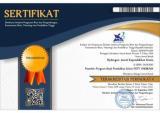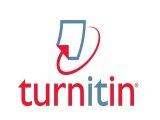Development of Articulate Storyline 3-Based for Chemical Bonding Teaching Materials
Abstract
The development of Articulate Storyline 3 (AS3)-based chemistry teaching resources on chemical bonding is the aim of this research. the subject of research was 10th-grade senior high school students. This research was conducted to investigate the form of creation and viability of chemical bonding teaching materials using the AS3 application. Minor modifications are made to the Borg and Gall method for instructional design for the production of AS3-based chemical bonding teaching materials. The technique consists of five steps: preliminary studies, product design plan (planning and development), product validation (validation design and revision), field trials, and final product dissemination. The instruments used in this study were interview sheets, questionnaires in the form of instrument validation for material experts, and media experts, tests for students, and documentation. Material expert data, media, and student responses were obtained and analyzed to describe the validity and feasibility of teaching materials. The findings indicated that the optimal percentage was 96.42%, while the very excellent percentage was 96.66%. The results of the evaluation of the feasibility of teaching materials by material specialists and media specialists were 83.07% and 84.61 %, respectively, in the very excellent category. According to the findings of expert evaluations and field testing of chemical teaching materials based on AS3, this chemical bond material is very appropriate for use in educational settings.
Keywords
Full Text:
PDFReferences
Aclufi, A., Fleming, M., Klymkowsky, M., Laursen, S., Vega, Q., & Werner, T. (2005). Doing Science: The Process of Scientific Inquiry. National Institute of General Medical Sciences. Mark Dabling Boulevard Colorado: Colorado Springs.
Arikunto, S. (2006). Prosedur Penelitian (Suatu Pendekatan Praktek). Jakarta: Rineka Cipta.
Bergqvist, A., Drechsler, M., Jong, O. De., & Rundgren, S. C. (2013). Representations of Chemical Bonding Models In School Textbooks-help or Hindrance For Understanding. https://doi.org/10.1039/c3rp20159g
Chandrasegaran, A.L., Treagust, D.F., & Mocerino, M. (2007). The development of a two–tier multiple choice diagnostic instrument for evaluating secondary school students’ ability to describe and explain chemical reactions using multiple levels of representation”. Chemistry Education Research and Practice, 8(3), 293 – 307.
Chittleborough dan Treagust. (2007). The modelling ability of non-major chemistry students and their understanding of the sub-microscopic level. Chemistry Education Research and Practice, 8 (3), 274-292. http://dx.doi.org/10.1039/B6RP90035F
Darmawan, D. (2011). Bahan Ajar: Mengembangkan Model Pembelajaran Multimedia Interaktif dengan Articulate. Garut: STKIP.
De Jong, T. (2010). Cognitive load theory, educational research, and instructional design: Some food for thought. Instr Sci, 38, 105–134. https://doi.org/10.1007/s11251-009-9110-0
Imron, M.J. (2019). Dampak Multimedia Bagi Peningkatan Kualitas Pembelajaran di Sekolah, Al-Ibrah, Jurnal Pendidikan dan keilmuan islam, 4 (1): 122-145.
Irwansyah, F. S., Nurasiyah, E., Maylawati, D. S., Farida, I., & Ramdhani, M. A. (2020). The Development of Augmented Reality Applications for Chemistry and Learning In Augmented Reality In Education. (V. Geroimenko, Ed.). Bandung: Springer International Publishing.
Jelita, Y., Handayani, D., & Amida D. (2021). Pengembangan Kit (Komponen Instrumen Terpadu) Praktikum Kimia Berbasis Guided Inquiry Pada Materi Asam Basa, Alotrop, 2021, 5(2): 149 -158. https://doi.org/10.33369/atp.v5i2.17120
Jespersen, N. D., J. E. Brady, & A. Hyslop. (2012). Chemistry: The Molecular Nature of Matter. The United States of America: John Wiley and Sons Inc
Kumpha, P., Suwannoi, P., & Treagust, D. F. (2014). Thai grade 10 students conceptual understanding of chemical bonding. Procedia - Social and Behavioral Sciences, 143, 657- 662, https://doi.org/10.1016/j.sbspro.2014.07.458
Krisnawat., Copriadi, J., Maria, E. (2023). Enhancing Science Literacy through Development of Acid-Base E-module using Book Creator. Hydrogen: Jurnal Kependidikan Kimia, 11(1), 60-67. https://doi.org/10.33394/hjkk.v11i1.5874
Ljubojevic, M., Vaskovic, V., Stankovic, S., & Vaskovic, J. (2014). Using supplementary video in multimedia instruction as a teaching tool to increase the efficiency of learning and quality of experience. The International Review of Research in Open and Distance Learning (IRRODL), 15(3), 275–291. https://doi.org/10.19173/irrodl.v15i3.1825
Mawardi. (2019). Rambu-rambu Penyusunan Skala Sikap Model Likert untuk Mengukur Sikap Siswa, Scholaria: Jurnal Pendidikan dan Kebudayaan, 9 (3): 292-304. https://doi.org/10.24246/j.js.2019.v9.i3.p292-304
Mayer, R. E. (2009). Multimedia learning (2nd edition). New York: Cambridge University Press.
Meltzer, D.E. (2002). The relationship between mathematics preparation and conceptual learning gains in physics: A possible “hidden variable” in diagnostic pretest scores, American Journal of Physics, 70(12), 1259-1268, December 2002. https://doi.org/10.1119/1.1514215
Nahum, T. L., Mamlok‐Naaman, R., Hofstein, A., & Krajcik, J. (2007). Developing a new teaching approach for the chemical bonding concept aligned with current scientific and pedagogical knowledge. Science Education, 91(4), 579-603. https://doi.org/10.1002/sce.20201
Oludipe, D., dan Awokoy, J. O. (2010). Effect of Cooperative Learning Teaching Strategy on the Reduction of Students’ Anxiety for Learning Chemistry, Journal of Turkish Science Education, 7 (1): 30-36.
Pabuccu, A., & Geban, O. (2012). Students’ conceptual level of understanding of chemical bonding. International Online Journal of Educational Sciences, 4(3), 563–580.
Pahriah and Hendrawani. (2019). Efektivitas Modul Inkuiri dengan Strategi Konflik Kognitif dalam Meningkatkan Keterampilan Berpikir Kritis Mahasiswa. Hydrogen: Jurnal Kependidikan Kimia, 7(2), 62-72. https://doi.org/10.33394/hjkk.v7i2.1796
Pérez, J.R.B, Pérez, M.E., Calatayud, M.L., Garcia-Lopera, R., Montesinos, S., & Gil, E.T. (2017). Student’s Misconceptions on Chemical Bonding: A Comparative Study between High School and First Year University Students, Asian Journal of Education and e-Learning, 5(1): 2321-2454.
Rusman, 1972-; Cepi Riyana, 1975-; Deni Kurniawan, 1969-. (2012.). Pembelajaran berbasis teknologi informasi dan komunikasi : mengembangkan profesionalitas guru / Rusman, Deni Kurniawan, Cepi Riyana. Jakarta: Rajawali Pers.
Safitri, B.R.A., Pahriah., Fuaddunnazmi, M. (2022). Efektivitas Video Pembelajaran Berbasis Zenius.Net dalam Meningkatkan Pemahaman Konsep Kimia Siswa. Hydrogen: Jurnal Kependidikan Kimia, 10(1), 34-41. https://doi.org/10.33394/hjkk.v10i1.5080
Sirhan, G. (2007). Learning difficulties in Chemistry: an overview. Journal of Turkish Science Education, 4 (2), 2-20.
Sugiyono. (2010). Metode Penelitian Pendidikan Pendekatan Kuantitatif, kualitatif, dan R & D. Bandung: Alfabeta
Thiagarajan, S., Semmel, D.S & Semmel, M.I. 1974. Instructional Development for Training Teachers of Exceptional Children. Indiana: Indiana University Bloomington. The USA.
DOI: https://doi.org/10.33394/hjkk.v11i2.7403
Refbacks
- There are currently no refbacks.

This work is licensed under a Creative Commons Attribution-ShareAlike 4.0 International License.





